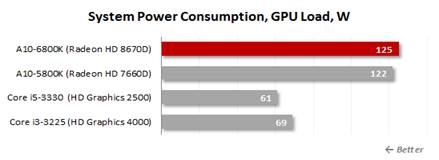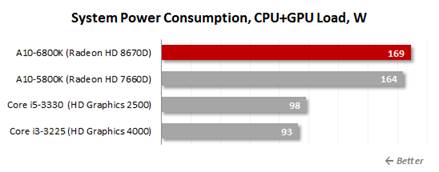Power consumption
The performance of the mixture Richland
processor increases due to slightly higher clock frequency. However, there is
no change in architecture or manufacturing process, making us a little worried
that their power consumption can also be increased. So, Trinity can’t be proud
of the good power consumption level, so it is not desirable.
To learn more about the power consumption of
the AMD A10-6800K APU, we make a special test cycle. The new digital power
supply unit from Corsair - AX760i - allows monitoring the consumption and
production electrical power, which we use active in the process of checking our
power consumption. The below graphs (unless otherwise stated) show the power
consumption of the entire PC (no monitor) measured after the power supply. This
is the total power consumption of all components of the system. The efficiency
of the PSU is not taken into account. The CPU is loaded by running the 64-bit
version of the Linx 0.6.4 utility. We use FurMark 1.10.6 utilities to load the
graphics cores. Moreover, we enable Turbo mode and all of the power saving
technology to precisely measure the power consumption of computers in idle
mode: C1E, C6, Enhanced Intel SpeedStep and AMD Cool 'n'Quiet.

Power
consumption in idle mode
In idle mode the AMD platform A10-6800K
system consumes a few watts more power than the same exact platform with
A10-5800K inside. This can be explained by the fact that for some reasons the
Richland minimum frequency in idle mode is set at 2.0 GHz, while Trinity
processor downgrades to 1.4 GHz.

Power
consumption, CPU Load
In the case of full load on a common goal
on Piledriver cores, the power consumption indexes of the AMD A10-6800K and
A10-5800K level out. That means the acceleration of Richland has not resulted
in charges higher power consumption and higher heat dissipation, and TDP is
declared for the different generations of Socket FM2 processors in fact
reflected the reality of things. Note that AMD A10-6800K consumes much more
power than Intel CPUs, this really is quite reasonable, because the calculated
TDP of Core i3 and Core i5 from Ivy Bridge generation are set in at 55 W or 77
W instead of 100 W by A10-6800K.

Power
consumption, GPU Load
Under heavy graphics load AMD A10-6800K and
AMD A10-5800K consume about the same amount of power, with a slight advantage
of the Trinity. Core i3 and Core i5 need less energy significantly in this
case, but it is important to remember that they also have much lower 3D
performance.

Power
consumption, GPU+CPU Load
Use full all types of cores in the mixture
processor reveal Richland that is still a little design consumes more power
than the Trinity. In fact, everything is for a reason. The differences, we
observe only 5 W. However, once again prove a little better power consumption
than their socket FM2 competitors. However, we will not draw any preliminary
conclusions at this time, until we get our hands a better Richland processor
with 65 W TDP.
Overclocking
Trinity does not spend a lot about the
overclocking. Of course, like new Richmond version, it includes the special
K-indexed model with unlocked frequency multiplier, but the Piledriver cores do
not have much untapped potentials because the Piledriver platform APU frequency
has higher frequency speed than 4 GHz even at their default settings. And
Richland APU is clocked higher without any change in the manufacturing process
or semiconductor design. That is why A10-6800K overclocks not much. The peak
frequency for our sample is 4.8 MHz, which is only higher Turbo frequency than
400 MHz. The voltage is increased to 1.5 volts and we cool with NZXT Havik 140
cooler.

Overclocking
Even so, the results should not be
underestimated. In fact, the Richmond, as represented by A10-6800K, is more
friendly form for people overclocking than its predecessor. We can’t achieve
clock speed as in our experiments with A10-5800K in the same cooling equipment.
Besides, the screenshot shows the
manufacturers, finally try to make the internal temperature sensor working more
or less correctly. It now reflects the actual values for the APU die
temperature. In this way, the highest permissible temperature for A10-6800K is
120°C, due to our overclocking is limited by the efficiency of cooling
equipment. But contrary to Haswell, A10-6800K temperature correlates directly
with its heat-sink, so alternative cooling equipment with higher efficiency
will help us to achieve higher clock speeds.
Remaining 42% of the APU can be
overclocked. We wish to refer to the graphics cores. After setting the voltage
at 1,425 volts, we integrate Radeon HD 8670D to work in 1,169 MHz, 325 MHz
higher than the default clock speed. We reduce the frequency of x86 APU to 4.7
GHz in this case to ensure the under load stability in the mixture.
As the final step in our mixture platforms
overclocking, we choose the highest system memory frequency. Richland
controller supports DDR3-2400 and we do not have any problems when initializing
this clock speed. As a result, we have a good overclocking platform with high
graphics performance than the default settings.

3DMark
result
Overall score of overclocked A10-6800K is
nearly higher 25%, its x86 part is accelerated by 10% in the physics game test.
The integrated Radeon HD 8670D is compared to Radeon HD 6670 graphics card when
overclocking.
Conclusions
No resolution occurs. The new computer mixtures
processor is formerly known as Richland and now belongs to the new 6000 version
that brings only minor changes to the socket FM2 platform. AMD tries to turn
Richland into a new hit, but if we put aside all the marketing promotion, then
we will see the Trinity processors with the slightly clock speed and nothing
else. However, even the few moments of joy that the new A10-6800K gives us
today are quite adequate. It's great to have the computing and graphics
performance at the same level of heat sink and power consumption as well as
experience improved overclocking results.
Overall, socket FM2 platform always leaves
a positive impression right from the start, especially when it comes to
graphics or inconsistent performance of the top version in the product line.
The AMD developers incorporate all their best efforts to give us and try to
implement some very attractive solutions based on it later, especially for the
price. Despite improvements in Richland are small, still undeniably and step
forward, it will allow AMD to maintain interest in their socket FM2 platform
least until their new heterogeneous Kaveri processors are ready to roll.
So, we will continue to introduce AMD A10
processor as great products for the office as well as inexpensive gaming or PC
entertainment. Of course, it is important to mention that the graphics
processors in the Trinity and Richland are integrated and do not support all
online games in Full HD resolution even with minimal image quality settings.
But many modern games will run on integrated AMD A10 graphics at a full frame
rate, while Intel is unable to provide even that. At least, until Haswell
microarchitecture is put into the sub $150 processor samples.
|
Specifications
·
Motherboard: Gigabyte F2-A85X-UP4
·
BIOS: F4
·
Chipset Driver: AMD Catalyst 13.6
·
DDR3 Memory: G.Skill RipJawsX 8GB (2 x 4GB)
·
Memory Timings: 11-11-11-30-2T @ 2,133MHz
·
Integrated Graphics: HD 8670D
·
Discrete Graphics: Nvidia GeForce GTX 780 3GB (ForceWare
320.18)
·
Disk Drive: Samsung 840 Pro 250GB
·
Optical Drive: Sony AD-7263S
·
Chassis: Corsair Graphite 600T
·
Power Supply: Corsair AX750
·
Operating System: Windows 8 64-bit
|